|
ESMOND - THE LOST IDOL
by Lord Astor of Hever PC DL
formerly The Life Guards
|
My great-uncle, Esmond Elliot, was a Lieutenant serving in the Scots Guards when, at the age of 22, he was killed on 6th August 1917 at the beginning of the Passchendaele Offensive. Like many of his generation, he considered it a privilege to take a share ‘infinitesimally small though it may be’ as he put it, in what the nation viewed as a terrible struggle against a brutal aggressor.
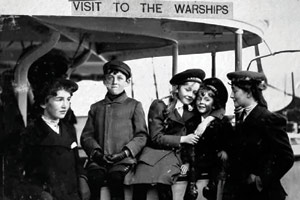 Ruby, Larry, Violet, Esmond and Eileen.
Ruby, Larry, Violet, Esmond and Eileen.
On board HMS Crescent, Quebec. 1899 |
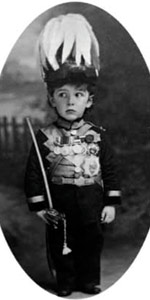
Esmond on stage in Ottawa wearing his father’s medals and feathered hat |
The Elliots were a close-knit family and Esmond was nurtured in a vibrant, stimulating and loving environment, a secure foundation which enabled him to grow into a confident, happy young man, able to make friends easily and bring out the best in others.
His father, the 4th Earl of Minto, my great-grandfather on my father’s side of the family, was successively Governor-General of Canada and Viceroy of India at the turn of the last Century. Described by Kitchener as ‘the best, most gallant and most able administrator that Britain ever produced’, through his warmth, tact and gentle humour, he commanded a following amongst those who served under him. His shrewdness and mental stamina, in particular, enabled him to navigate through a challenging, transformative period in the history of the Raj. He was also a distinguished sportsman and steeplechase jockey, riding at Aintree for four consecutive years between 1874 and 1877 and winning the French Grand National in 1874. Esmond’s mother, Mary Minto, was a woman of beauty, intelligence and sparkle; on her return from India in 1910, she became a Lady-in-Waiting to Queen Mary, which placed her at the centre of the royal circle for the remaining 30 years of her life.
As a very young boy, Esmond travelled to Canada with his parents, but didn’t follow them to India when they succeeded the Curzons in 1905; it meant a cruelly long separation, the fruit of which was a voluminous, simultaneously touching and humorous, correspondence. Lady Minto kept all her son’s letters, diaries and school reports; when she lost him so young in battle, this exchange of words on paper, going back over the years, must have been consoling and, at the same time heart-breaking, in its testimony to the long periods of time apart.
Family papers and photographs chart Esmond’s life from his time in Canada, through prep school and Eton, including a four-month sojourn in India in 1906/7. His father’s position, the most senior one in the Empire after the King, and his mother’s royal connections, meant that he came across an extraordinary number of interesting and influential people, yet this exposure to a life of privilege did nothing to spoil him. It increased his confidence and maturity making him curious and perceptive with regard to other people. He also retained a wonderful modesty and shied away from any form of pomposity - either in himself or in others. He seemed to be aware of how fortunate he was and he was quietly thankful. His ability to communicate and inspire trust helped him enormously when he joined the Army.

At Eton, in ‘Pop’. 1913
|
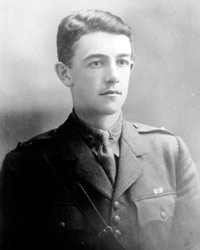
Esmond in the uniform of the Lothians & Border Horse Yeomanry. 1916
|
War broke out eight months after Esmond left Eton; he was on the brink of manhood and about to enter an exciting new phase of life, one which held great promise. Postponing his studies at Cambridge, he joined the Lothians & Border Horse Yeomanry, and in February 1916, he was appointed ADC in France to Major General Sir Geoffrey Feilding, in command of the Guards Division. At this point, the Army was preparing for the Battle of the Somme. It was a period of intensive learning, necessitating patience and diplomacy, where he was exposed to the routines and demands of senior commanders; he was afforded an insight into the Army’s hierarchy, management and handling of logistics. He came into contact with several British and French Generals and politicians and also the Prince of Wales, who was in the Grenadiers and who left Esmond his horses and saddlery when he returned to England.
Esmond was anxious to exchange his ring-side seat for the fight itself and, in August 1916, he left his staff position and joined the Scots Guards, a move which would take him to the frontline. Lord French, a neighbour of Lady Minto’s in London, tried to persuade her that it would be in everyone’s interest for Esmond to remain with Feilding, but her characteristically unselfish response was that she respected her son’s desire to be more actively involved in the war.
During the bitter winter of 1916/17, Esmond saw fierce fighting on the Somme, when his Battalion suffered terrible losses. His role was particularly important in the build up to Third Ypres in July 1917; he led a daring and strategically important raid across the Yser Canal into No Man’s Land on the other side and discovered that the Germans were holding the line very weakly - almost not at all. Thanks to this vital intelligence, a part of the Guards Division was able to begin its attack, from a much more advantageous position, several days before the main offensive planned for 31st July. A week later he was killed by a single bullet near the Steenbeek, whilst in charge of his Company.
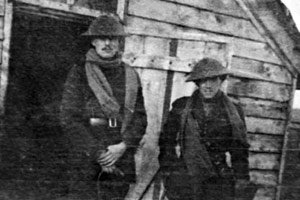
Victor Perowne and Esmond, ‘The Long and the Short’, outside Maltzhorn Farm before going into the line, 23rd December 1916
|
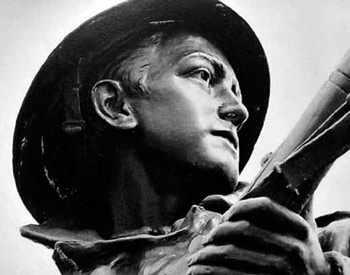
Minto War Memorial, unveiled by Field Marshal Earl Haig, 18th September 1921. The face is modelled on Esmond
|
Esmond, The Lost Idol is made up as much of the profound impressions made by my great-uncle on everyone who met him, as of his own experiences of life, on and off the battlefield. Esmond’s diaries and letters are a mine of humorous anecdotes concerning senior commanders and fellow officers in the Guards and, together with a young man’s experience of war, we are afforded an intimate glimpse of a bygone age. Yet the themes are timeless: love and friendship, loss and the need to preserve memories. And, of course, in researching and writing about Esmond, Alex and I came across some fascinating characters: the colourful Amir of Afghanistan, whose friendship with the Mintos on his extended visit to India partly influenced his country’s decision to maintain neutrality, despite fierce pressure to join the Central Powers; Hugh Macnaghten, the brilliant Classics beak at Eton who, losing 53 boys in his House was ultimately unable to cope with his grief; and Wilfrid Ewart, a brother officer in Esmond’s battalion, who wrote about their joint experiences in Way of Revelation, a post-war battlefront best-seller, published in 1921 where Esmond appears as Eric Sinclair, one of the two protagonists.
My inspiration for the book came from my grandmother, Violet Astor, the youngest of Esmond’s three elder sisters, who was particularly close to her beloved younger brother. His death was her third bereavement in as many years; she helped her mother put together a record of his life, reliving ‘those joyous twenty-two years’.
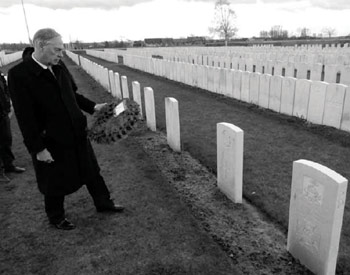
The Author laying a wreath on Esmond’s grave,
Mendinghem Military Cemetery, Belgium, 2014
|
We were overwhelmed at times by the volume of papers and photographs and the painstaking detail with which they were assembled - also by the sentiments expressed in letters and the measures taken to remember Esmond - and had a truly difficult task in deciding what to include and what to leave out. And handling Esmond’s keepsakes and personal belongings, beautifully preserved by Lord Minto in the Borders, was moving beyond words. Equally poignant for me was the knowledge that it was Douglas Haig, my mother’s father, who in 1921 unveiled the beautiful Minto Memorial, whose face is that of Esmond.
Esmond - The Lost Idol by Johnnie Astor and Alexandra Campbell, published by Helion, September 2017. |
|







